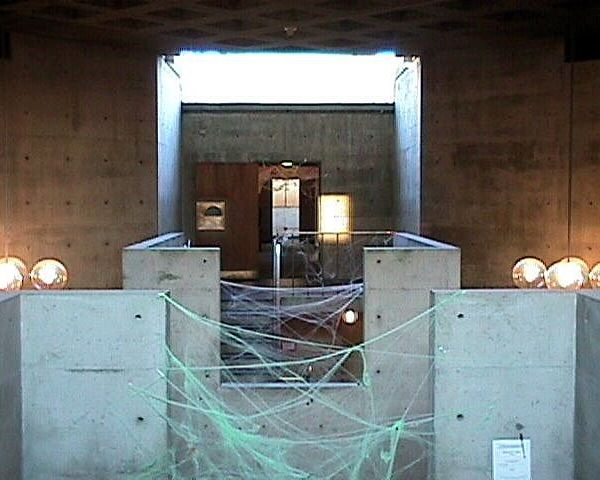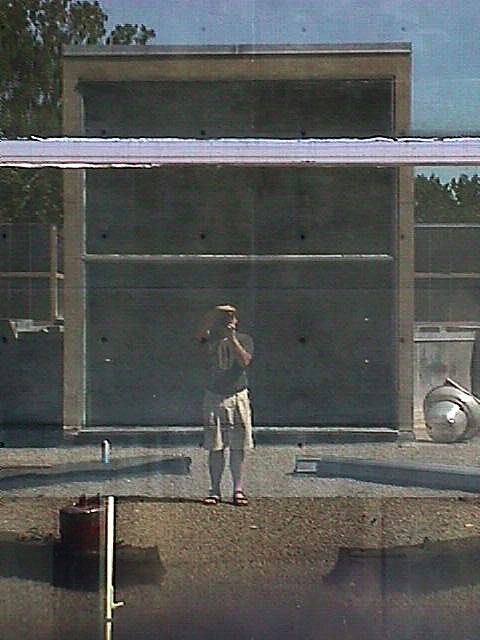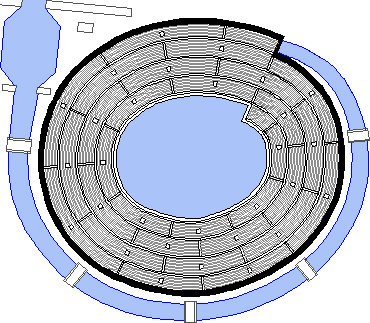2016.03.05 17:37
guess the building [famous] based on an interior [shot]
Trick or treat?

2016.03.05 17:53
guess the building [famous] based on an interior [shot]
Up on the roof.

| |
2016.03.05 18:23
guess the building [famous] based on an interior [shot]
Yes, Erdman Hall, Bryn Mawr College.
2016.03.15 18:04
#ilookup vs. Bjarke on 60 Minutes
The 60 Minutes feature on the NYC work of BIG and Bjarke Ingels does a very good job of making a much larger public aware of BIG and Bjarke Ingels--there's nothing quite like free national PR. But to think that it somehow benefits other architects is unreasonable at best.
The only people to benefit from the AIA commercials are the advertising agency and the network broadcasters, i.e., the people actually making money off the ad.
The following are excerpts from "why don't architects know how to work the media?" (almost 11 years ago):
"My feeling has been all along, however, that architects and architecture are well capable of generating their own publicity, but professional 'decorum' has for the most part made that attitude an ethically and aesthetically wrong position for architects to take. This 'wrong-ness' is really just a fabrication, an artificial restraint, and, as always, it is precisely at these artificial points where 'institutions' are the weakest, where the decay happens, where things begin to fall apart. I wholeheartedly advocate architects to embrace publicity as a new, additional ingredient that makes good architecture, the same as firmness, commodity, and delight make good architecture. Furthermore, I hope it takes less than twenty years for architects to begin creating and directing web sites that are just the same as television channels."
--excerpt from AD[vocating] PUBLICITY
"While your question (rightly) centers on creative similarities between disparate artists/designers, a related phenomenon in our time is the effective role of the hired publicist. Recently, I mentioned that Frank Gehry's cardboard furniture was featured in a 1972 issue of Life magazine. I have my own collection of 1972 Life magazines that I received by subscription back then and which I've been taking apart over the years, but I also recently purchased a lot of them via eBay, thus my renewed knowledge of what is in these magazines. I wanted to show the Gehry feature but I didn't bookmark it. So, instead of looking through all the magazines again, I looked up the article in a Gehry bibliography, and I was surprised to find that there were over a dozen 1972 publications that featured an article on Gehry's cardboard furniture. In this case, the 100th monkey is more specifically the 100th magazine editor contacted by a publicist."
--excerpt from Re: Monkeys and designers
How about architecture ads on ladies' intimate apparel, or even on packages of lunchmeat? ;-)
I heart QUONDAM ARCHITECTURE tee-shirts?
"Looks like your house could use some architectural viagra!" commercials?
Rem and Zaha already have their brand.
Why don't more architects have their own brand?
That's what I see as the real issue of this thread
There's marketing/advertising architecture, and there's marketing/advertising one's services as an architect. I think too many architects feel they have to market/advertise architecture in general before they can advertise their architectural services.
Is it possible for architects to market themselves as a service that will essentially brand the client?
[Interior decorators maybe kinda sorta do this if they make their clients feel like the product is really a reflection of them, the clients, as opposed to a reflection of the designer.]
Just remain mindful of the distinction between publicity and marketing. Granted, any publicity today boils down to marketing (like what isn't product placement anymore?), but, if I were marketing, I'd make damn sure that it is MY "values and principles" that the target audience takes note of and remembers. Why should I waste my time marketing architecture in general, which boils down to marketing all architects. That would be like advertising for the competition, wouldn't it?
...you really don't get it, do you?
The question of this discussion is: "why don't architects know how to work the media?"
It now seems clear to me that architects don't know how to work the media because they don't see that "self promotion" is basically all that "working the media" is about.
...but the topic here is "working the media" and marketing, not education, per say.
I wasn't kidding when I wrote that it would be awesome to see pixelwhore pimping HOT ROD ARCHITECTURE in a commercial. Would this commercial need something like the AIA promoting architecture as well? I don't think so. Would this commercial need something like walking tours and grade school presentations promoting architecture as well? I don't think so.
... is right about specifically knowing what to market, and here the notion of having a brand, albeit not absolutely necessary, nonetheless helps.
Maybe some of the problem stems from the (educated?) notion that architecture is some sort of homogeneous product (like milk or beef), where, in reality, architecture is extremely diverse in its many manifestations. Maybe what the public really needs is to see how many architectures are really available to them.
The point of marketing is not to "get them to care," it's to get them to buy the product!
If there were more architects self promoting their particular "brand" of architectural service, then the public at large would be much better informed as to what is actually available to them via architectural services.
| |
2016.03.17 10:38
BIG unveils moat-encircled stadium design for D.C.

The Naumachia Domitiani is truly a unique amphitheater because of its unprecedented spiral versus concentric formation. Rather than set in concentric tiers, this naumachia's grandstands form a continuous spiral ramp, beginning at the lowest seats and ending at the highest. The spiral design is further reinforced by the surrounding canal, which feeds from the Tiber to the naumachia's aquatic stage, and Piranesi would have us believe the canal concealed under the stadium continues in a spiral path because he indicates the water's stage-entrance at the step in the stage perimeter's oval.
The Naumachia Domitiani, like the Porticus Vipsania and the Porticus Alexandri Severi, is one of the buildings along the Ichnographia's Equiria that represents an actual ancient Roman building. According to Suetonius, the emperor Domitian ordered the digging of a lake, "close to the Tiber, surrounded with seats, and used for almost full-scale naval battles."¹ Domitian's naumachia did not last long however, because it's stones were later used to repair fire damage at the Circus Maximus. Since there is no archeological record of the lake's actual site along the Tiber, Piranesi's position of the Naumachia Domitiani is therefore discretionary at best. Likewise, with no record of the real naumachia's design, Piranesi's spiral amphitheater reflects Piranesi's own architectural imagination rather than historical substantiality. Nevertheless, the Naumachia Domitiani plays an important role within the planned military program of the Ichnographia's Equiria.
Situated approximately one-third up the one and a half mile race-course, the Naumachia Domitiani, through its massiveness and presumed height alone, is a prominent presence along the Equiria. Piranesi also positions the Naumachia Domitiani together with the Templum Castorum and the Templum Deorum Larium Parmarini, which consequently forms a group of buildings dedicated to ancient Rome's naval military forces. Like the Equiria, the Naumachia Domitiani is a showplace, however, where the Equiria is for a horse-race on land, the Naumachia is for a battle at sea. This contrast in "martial" display, moreover, is deftly accentuated by the rigid linearity of the Equiria versus the spiral curvature of the Naumachia and its surrounding canal. Hence, the Equiria and the Naumachia Domitiani together represent the overall amphibious nature of ancient Rome's military forces.
2816
2016.03.17 18:41
BIG unveils moat-encircled stadium design for D.C.
It was summer, 1978. I was working for HABS in eastern Missouri and a schoolmate was working in western Missouri, just outside Kansas City. Since I was the one with the car, I drove to Kansas City a few weekends that summer. One trip was to go to a stadium concert--Dan Fogelberg, Linda Ronstadt, and The Eagles. Like a lot of other people, we got to Arrowhead Stadium well before it opened, and, instead of waiting in some line, everyone just spread out their blankets and 'camped' on the very wide concrete paving all around the stadium, and we did the same. While the others of our group went for a walk around the stadium, I stayed on the blanket sunbathing. Upon my classmate's return, he asked, "Anything happen while we were gone?" "Not really, but, if there was the sound of surf in the background, I would swear I just spent the last half hour on a crowded beach."
|